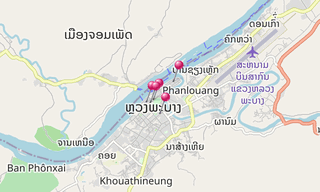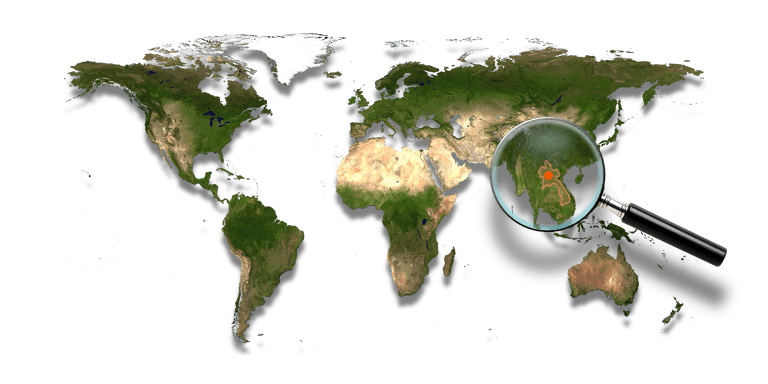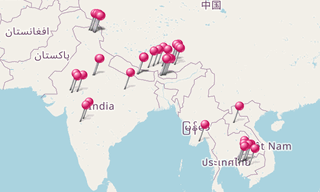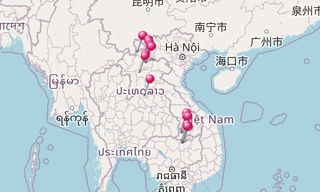Luang Prabang, formerly the capital of the Kingdom of Laos, is a city located in north central Laos, on the Mekong River. The capital was moved in 1560 by King Setthathirath I to Vientiane. The city belongs to the UNESCO World Heritage Site.
Luang Prabang is well known for its numerous Buddhist temples and monasteries. Every morning, hundreds of monks from the various monasteries walk through the streets collecting alms. One of the city’s major landmarks is Mount Phou Si; a large steep hill which despite the constrained scale of the city, is 130 m high; a steep staircase leads to Wat Chom Si shrine and an overlook of the city and the rivers.
Haw Kham
The Royal Palace (Haw Kham) of Luang Prabang is a building built between 1904 and 1909, during the time of the French Protectorate of Laos, for King Sisavang Vong and his family.
Mount Phou Si
Mount Phou Si (Mount Phu Si), is a high hill in the centre of the old town of Luang Prabang. It lies in the heart of the old town peninsula and is bordered on one side by the Mekong River and on the other side by the Nam Khan River. The hill is a local religious site, and houses several Buddhist shrines. 328 steps leads to the summit.
Wat Mai Suvannaphumaham
Wat Mai (Wat Mai Suvannaphumaham), typical of Luang Prabang architecture, is also called Banpakham. King Anourouth (Anurutha) wanted, in 1796, to build the most beautiful of the monasteries for his capital, but he was prevented from doing so. It was in 1821 that King Manthaturat (Manthaturath), began its construction, or restoration, to make it the largest and most richly decorated of the temples of Luang Prabang. It was completed in 1891, during the reign of King Sakhalin (Zakarin). It is there that on the occasion of the New Year, the Phra Bang (the statue of the Golden Buddha), is brought from the Royal Palace, to be exhibited for the veneration of the people.
An Emerald Buddha statue sits inside the building’s red and gold interior. Wat Mai, is the residence of the highest dignitary of the Lao Buddhist Church, the Supreme Patriarch, whom the new regime now calls the president of the monks.
Wat Visunarat
Wat Visoun (Wat Visunarat), the oldest temple still in use in Luang Prabang was built in 1513 by King Visunarat (Vixun or Vixoun) who reigned in Lan Xang from 1501 to 1520. He was crowned king on a stormy day in 1501 hence his name of the reign of Vixun (in Pali vijjutâ, that is to say lightning). Inside there has been a museum since 1942 with numerous Buddha statues, especially the typical gesture of Luang Prabang (standing with overlong arms pointing down parallel to the body).
Wat Xieng Thong
Wat Xieng Thong is a Laotian Buddhist temple in the former royal capital Luang Prabang. Founded in 1560 by King Setthathirat of Lan Xang, it is generally considered the most elegant in the country. Located between the Nam Khan and the Mekong, it is the center of a small group of religious buildings, including a pavilion for the funeral chariot of the ancient kings of Laos.
Wat Xieng Thong’s Sim is composed of nine cascading roofs and is decorated by gold stenciling. The roofs are a central element of the structure, sweeping downward in an elaborate array. Along the center of the roof is the Dok So Fa, small pagodas covered in gold that hook upwards to the sky. The number of pagodas and overall detail of this floral sculpture signifies the relative importance of a Laotian temple.
On one side of the sim, there are small halls and stupas that contain Buddha images of the period. There is a reclining Buddha sanctuary, which contains an especially rare reclining Buddha that dates back to the construction of the temple. In the near compound’s eastern gate stands the royal funerary carriage house, where it houses the funeral carriage, which stands 12 m high and there are various urns for the members of the royal family.
The interior of the Sim is similarly adorned by gold stenciling. Rich red and black walls are decorated completely with gold stencils of mythological scenes and geometric design. The ceiling displays Dharmachakras — dharma wheels symbolising Buddhist law and the circle of reincarnation. The rear gable is decorated with a glass mosaic depicting the tree of life. Behind the Sim is the Sanctuary of the Reclining Buddha, a small chapel decorated with mosaics and featuring a large Buddhist statue.
Many other structures fill the compound and complement the Sim, including the Kouti, Ho Tai, and Hor Kong, the library, monk living space, and boat house, respectively.

.hero.landscape.jpg?w=1600)


.jpg?w=256)
.jpg?w=256)
.jpg?w=256)
.jpg?w=256)
.jpg?w=256)
.jpg?w=256)
.jpg?w=256)
.jpg?w=256)
.jpg?w=256)
.jpg?w=256)
.jpg?w=256)
.jpg?w=256)
.jpg?w=256)
.jpg?w=256)
.jpg?w=256)
.jpg?w=256)
.jpg?w=256)
.jpg?w=256)
.jpg?w=256)
.jpg?w=256)
.jpg?w=256)
.jpg?w=256)
.jpg?w=256)
.jpg?w=256)
.jpg?w=256)
.jpg?w=256)
.jpg?w=256)
.jpg?w=256)
.jpg?w=256)
.jpg?w=256)
.jpg?w=256)
.jpg?w=256)
.jpg?w=256)
.jpg?w=256)
.jpg?w=256)
.jpg?w=256)
.jpg?w=256)
.jpg?w=256)
.jpg?w=256)
.jpg?w=256)
.jpg?w=256)
.jpg?w=256)
.jpg?w=256)
.jpg?w=256)
.jpg?w=256)
.jpg?w=256)
.jpg?w=256)
.jpg?w=256)
.jpg?w=256)
.jpg?w=256)
.jpg?w=256)
.jpg?w=256)
.jpg?w=256)
.jpg?w=256)
.jpg?w=256)
.jpg?w=256)
.jpg?w=256)
.jpg?w=256)
.jpg?w=256)
.jpg?w=256)
-Cave-19-(Chaitya-Griha).hero.jpg?w=320)

.hero.jpg?w=320)

.hero.jpg?w=320)
.map.png)